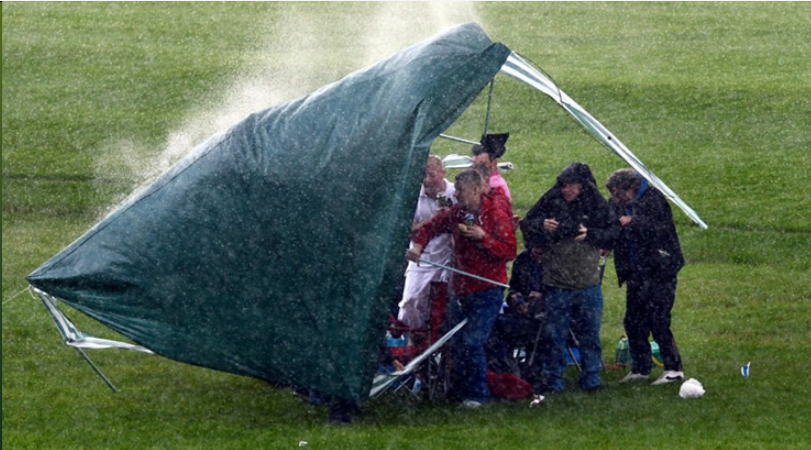10 Ways To Weigh Your Pop Up Gazebo Down
31st Aug 2023

Gazebos, particularly the lightweight or portable types, can easily tip over or get blown away by strong winds.
This guide delves into various methods to weigh your gazebo down, helping it remain stable during harsh weather conditions and preventing the gazebo sides from flapping incessantly in the wind.
Why Do I Need To Weigh My Gazebo Down?
The lightweight design and large surface area of pop up gazebos make them vulnerable to winds, leading to instability or even severe accidents. Knowing how to secure your gazebo not only increases its durability but also enhances the safety of its occupants. It's a necessary step to maintain your gazebo's lifespan and maximise its use.
10 Effective Ways to Weigh Down Your Gazebo
1. Use Gazebo Weights or Sandbags
Commercially available gazebo weights or sandbags are specially designed for this purpose. They often come with handles or straps, allowing them to be easily attached to the legs of the gazebo.
The main advantage of these weights is their convenience and effectiveness. However, the amount of weight provided by these sandbags can vary, so be sure to choose one that's adequate for your gazebo and weather conditions.
2. Utilise Water-filled Containers
Water-filled containers are a cost-effective and efficient alternative to traditional gazebo weights. They can be anything from plastic barrels to jugs. The beauty of this method is in its simplicity and portability. You can fill the containers on-site, thereby avoiding the inconvenience of transporting heavy weights. After use, simply empty the containers for easy transportation.
3. Implement Weighted Planters
Weighted planters can provide a significant amount of weight while adding an aesthetic appeal to your gazebo. Planters can be filled with soil and plants, which can be surprisingly heavy. Placing a few of these around the legs of your gazebo not only secures the structure but also enhances its look. However, they can be a little difficult to move, making them more suited for permanent or semi-permanent gazebos.
4. Take Advantage of Weight Plates

Weight plates, usually used for barbells or dumbbells, can also be used to weigh down a gazebo. The plates can be stacked over the gazebo legs or tied to the structure with ropes. This method is advantageous due to the high weight achievable and the ease of weight adjustment. However, these plates might not complement the aesthetics of your gazebo.
5. Use of Concrete Blocks
Concrete blocks are incredibly sturdy and heavy, making them an excellent choice for weighing down a gazebo. They can be placed around the legs of the gazebo, adding a significant amount of weight. The drawback is their weight and bulkiness, which make them difficult to transport and more suited for permanent gazebo installations.
6. Anchor with Auger-Style Ground Stakes
Ground stakes can be an effective method for securing a gazebo, especially if it's situated on soft ground. Auger-style stakes are twisted deep into the ground and attached to the gazebo with a rope or strap. They provide excellent resistance against wind, keeping the gazebo firmly in place. However, they might not be effective in hard or rocky soils.
7. Attach Weight Bags to Gazebo Legs
Weight bags are a versatile and portable option to weigh down a gazebo. These bags can be filled with either sand or rocks and are typically designed to wrap around or hang from the gazebo legs. The amount of weight added can be adjusted by changing the amount of filler in the bags, offering flexibility.
8. Understand The Ground You’re Working With Bury the Legs in Soil
Soft Standings (Soil): Burying the legs of the gazebo in the soil can provide excellent stability, especially for permanent installations. This method involves digging holes for the gazebo legs and filling them after the gazebo is installed. The soil acts as a natural weight, holding the gazebo firmly in place. However, this method requires more effort and is not suited for temporary or portable gazebos.
Hard Standings: If securing your gazebo to hard standings, it’s best to use footplates. Bolt your gazebo through the holes in the footplates for best results. If running a market stall, you might find that a lot of markets have attachments in the ground to bolt your footplates to. If not, simply drill and bolt into the ground using your special fixings.
9. Utilise Guy Lines and Pegs
Guy lines are sturdy ropes that can be attached to the gazebo and anchored into the ground using pegs. They provide additional stability, especially in windy conditions. They also help to stop gazebo sides flapping by ensuring the structure remains taut. The downside is that they can be a tripping hazard, so they need to be installed carefully.
10. Combine Different Methods for Increased Stability
In many cases, using a combination of methods can provide the most effective solution. For instance, you might use gazebo weights for the main weight and then add guy lines for extra stability in the wind. Or, you might use concrete blocks for a permanent gazebo, but add sandbags for additional weight during particularly windy seasons. The key is to consider your specific needs, the size and type of your gazebo, and the weather conditions you're likely to encounter.
How To Choose The Right Weighting Method For Your Gazebo
Consider Your Gazebo Material
The material of your gazebo can influence the type of weights required. Metal gazebos are generally heavier and more stable than their plastic or fabric counterparts and might not need as much additional weight.
Factor in Local Weather Conditions
If you live in an area with frequent high winds, you'll need heavier weights or multiple weight sources to secure your gazebo.
Consider Your Budget
The costs of the various methods vary. While concrete blocks or sandbags can be inexpensive, purpose-designed gazebo weights may cost more.
Take Into Account Storage and Transportation
If you frequently move your gazebo, consider portable and easy-to-store options like water-filled containers or sandbags.
Safety Considerations When Weighing Down A Gazebo
Ensuring the safety of those using the gazebo should always be a priority, and this begins with the correct setup. Here are some key safety considerations when weighing down your gazebo:
1. Even Weight Distribution: It's important to distribute the weights evenly across the gazebo to maintain balance. Weights should be equally allocated to all legs of the gazebo.
2. Secure Fastening: The weights should be securely fastened to the gazebo to prevent them from slipping or falling off. This is especially important for weights like sandbags or weight bags that are attached to the gazebo legs. Make sure the attachments are strong enough to handle the weight and the wind forces.
3. Avoid Tripping Hazards: If you're using methods like guy lines or cords, ensure they are clearly visible to prevent tripping. Tripping over guy lines can cause injury and can also damage the gazebo. Using reflective or brightly coloured guy lines can help improve visibility.
4. Wind Considerations: Always consider the potential for wind when setting up your gazebo. Even with weights, high winds can potentially lift a gazebo or cause it to flip. If very high winds are forecast, it may be safer to take down the gazebo temporarily.

5. Regular Maintenance: Regularly check your gazebo and the weights for any signs of wear and tear. Damaged weights or a weakened structure can compromise the stability of the gazebo, putting users at risk.
? For more information, check out these gazebo maintenance tips.
6. Follow Manufacturer's Instructions: Always adhere to the manufacturer's instructions regarding the setup and weighing down of your gazebo. The manufacturer's instructions typically provide the safest and most effective way to secure the particular model of gazebo you have.
7. Weight Limit: Avoid exceeding the recommended weight limit for your gazebo. Overloading the gazebo can damage the structure and reduce its stability, which can be dangerous.
By taking these safety considerations into account, you can ensure that your gazebo is not only stable but also a safe place for you and your guests to enjoy.
Weights Are Your Gazebos Best Friend
Securing your gazebo is a critical aspect of its installation. It not only protects the structure and increases its lifespan but also ensures the safety of its users. From using gazebo weights to burying the legs in soil, there are many ways to weigh down your gazebo. Choose the method that best fits your gazebo type, local weather conditions, and personal preferences.
Check out our range of gazebo weights and stakes here.
Frequently Asked Questions
How much weight do I need to secure my gazebo?
The weight required to secure your gazebo can vary depending on the size of the gazebo and weather conditions. A general rule is to have at least 27kgs of weight per leg for an average-sized gazebo in average windy weather.
Can I use homemade weights to secure my gazebo?
Yes, homemade weights such as sandbags, water-filled jugs, or concrete blocks can be used to secure a gazebo. However, to avoid any accidents, it’s always best to purchase professional weights.
How can I secure my gazebo on a concrete surface?
For concrete surfaces, you can use weighted bags, gazebo weights, water-filled containers, or weight plates. Drilling into the concrete with footplates and bolts is also an option, but it may require permission and expertise.
Can a gazebo be secured without weights?
While it's possible to secure a gazebo using ground stakes or by burying the legs in the soil, using weights significantly enhances the stability and safety of the gazebo, especially in windy conditions.










